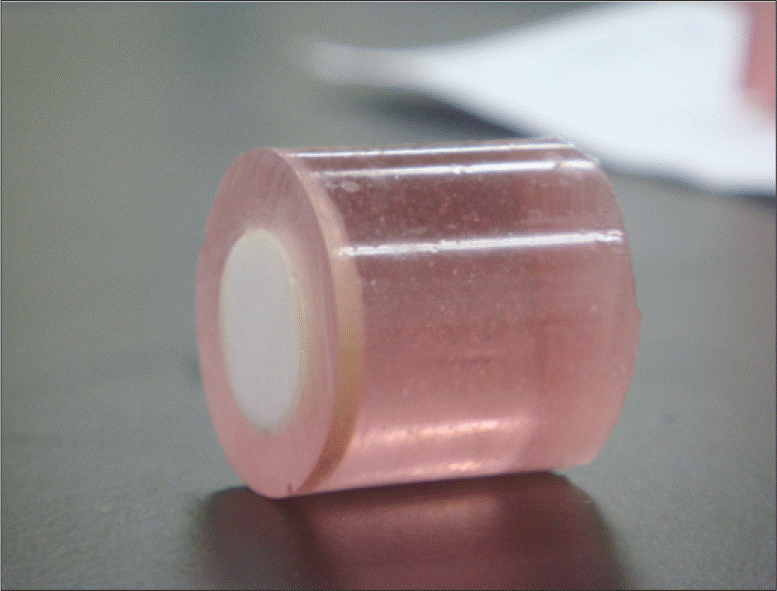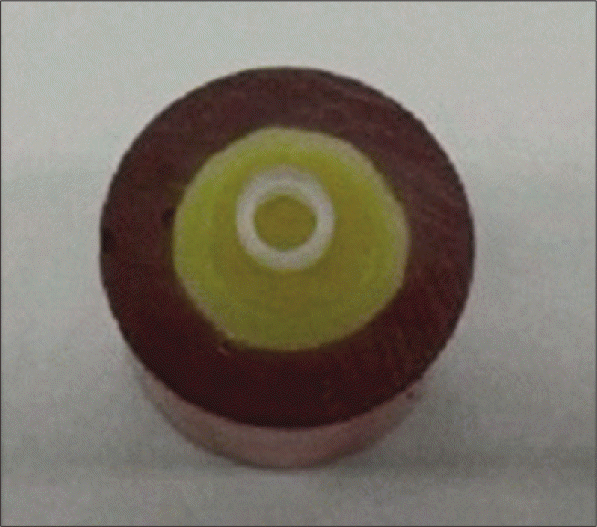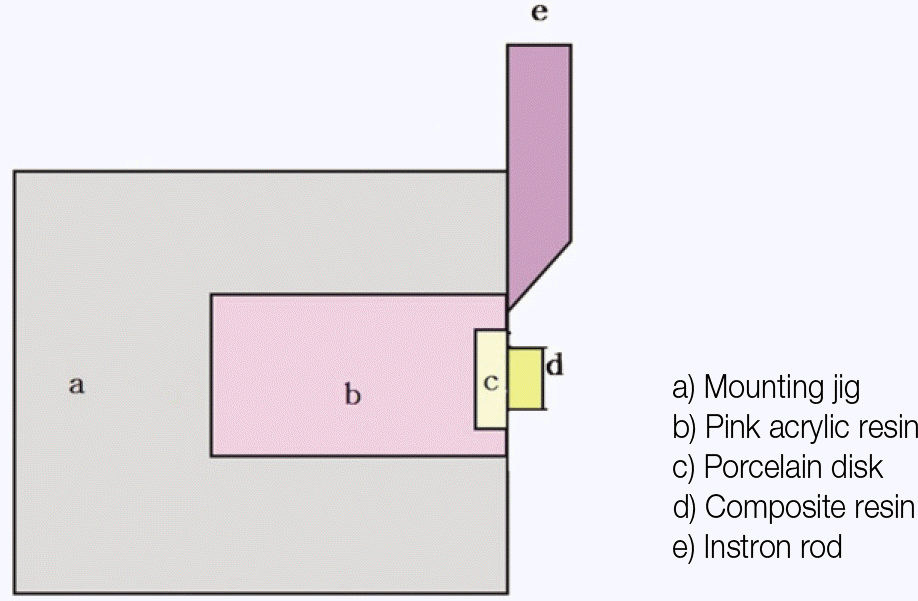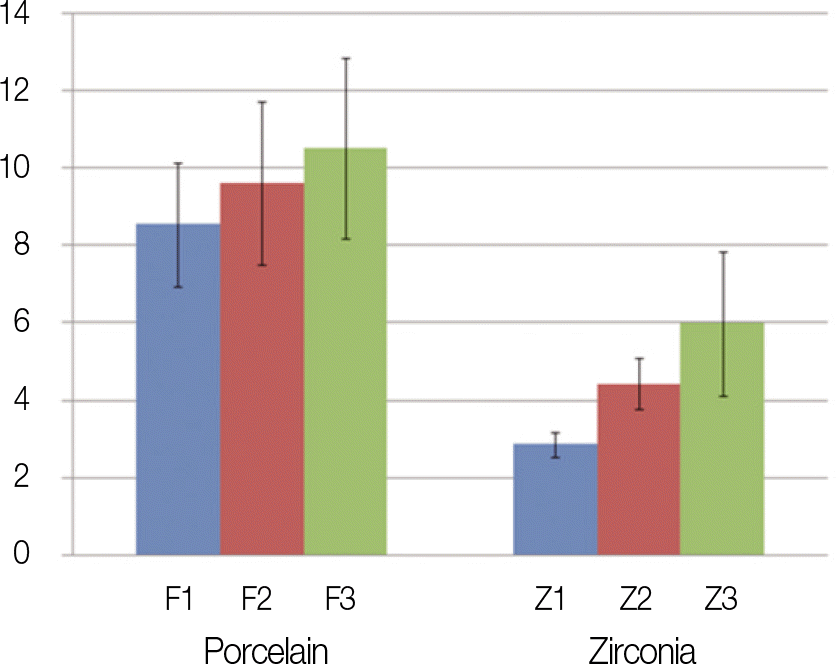Abstract
Purpose
The purpose of this study is to evaluate the effect of applying Silano-pen to feldspathic porcelain and zirconia on shear bond strength with composite resin.
Materials and methods
Feldspathic porcelain and zirconia specimens were produced into 30 per each 2 mm thick and 12 mm in diameter and their surface was made smooth and even and then embedded in acrylic resin. The specimens were divided into each Group F (Feldspathic porcelain) and Group Z (Zirconia), (1) Hydrofluoric acid etching and silane (F1 & Z1), (2) Silano-pen and silane (F2 & Z2), (3) Hydrofluoric acid etching and Silano-pen, silane (F3 & Z3). After surface conditioning, substrate surfaces of the specimen were examined by SEM. Composite resin cylinders (2 mm high, 3 mm in diameter)were bonded to specimen and shear bond strength between ceramic and composite resin was measured by using universal testing machine. The measured values were statistically analyzed by using two way ANOVA and Tukey's multiple comparison test (α =.05).
Results
In the scanning electron micrograph of the treated ceramic surface, Group F2 and F3 appeared the high roughness and Group Z3 appeared the highest density of silica particle. In Feldspathic porcelain, the result of measuring shear bond strength showed that Group F3 was measured to be highest and Group F1 was measured to be lowest but there was no statistical significance among Groups. In zirconia, Group Z3 was measured to be highest and Group Z1 was measured to be lowest and there was statistical significance among Groups (P<.05).
Go to : 
REFERENCES
1.Aida M., Hayakawa T., Mizukawa K. Adhesion of composite to porcelain with various surface conditions. J Prosthet Dent. 1995. 73:464–70.

2.Haselton DR., Diaz-Arnold AM., Dunne JT Jr. Shear bond strengths of 2 intraoral porcelain repair systems to porcelain or metal substrates. J Prosthet Dent. 2001. 86:526–31.

3.Della Bona A., Anusavice KJ., Shen C. Microtensile strength of composite bonded to hot-pressed ceramics. J Adhes Dent. 2000. 2:305–13.
4.Oh WS., Shen C. Effect of surface topography on the bond strength of a composite to three different types of ceramic. J Prosthet Dent. 2003. 90:241–6.

5.Lee JY., Im EB. A shear bond strength of resin cements bonded to pressable porcelain with various surface treatments. J Korean Acad Prosthodont. 2003. 41:379–86.
6.Kupiec KA., Wuertz KM., Barkmeier WW., Wilwerding TM. Evaluation of porcelain surface treatments and agents for composite-to-porcelain repair. J Prosthet Dent. 1996. 76:119–24.

7.Pameijer CH., Louw NP., Fischer D. Repairing fractured porcelain: how surface preparation affects shear force resistance. J Am Dent Assoc. 1996. 127:203–9.

8.Diaz-Arnold AM., Wistrom DW., Aquilino SA., Swift EJ Jr. Bond strengths of porcelain repair adhesive systems. Am J Dent. 1993. 6:291–4.
9.Leibrock A., Degenhart M., Behr M., Rosentritt M., Handel G. In vitro study of the effect of thermo- and load-cycling on the bond strength of porcelain repair systems. J Oral Rehabil. 1999. 26:130–7.

10.Suliman AH., Swift EJ Jr., Perdigao J. Effects of surface treatment and bonding agents on bond strength of composite resin to porcelain. J Prosthet Dent. 1993. 70:118–20.

11.Oh WS., Shen C. Effect of surface topography on the bond strength of a composite to three different types of ceramic. J Prosthet Dent. 2003. 90:241–6.

12.Luthardt RG., Holzhu¨ter M., Sandkuhl O., Herold V., Schnapp JD., Kuhlisch E., Walter M. Reliability and properties of ground Y-TZP-zirconia ceramics. J Dent Res. 2002. 81:487–91.
13.Bottino MA., Valandro LF., Scotti R., Buso L. Effect of surface treatments on the resin bond to zirconium-based ceramic. Int J Prosthodont. 2005. 18:60–5.

14.Janda R., Roulet JF., Latta M., Damerau G. Spark erosion as a metal-resin bonding system. Dent Mater. 2007. 23:193–7.

15.Llobell A., Nicholls JI., Kois JC., Daly CH. Fatigue life of porcelain repair systems. Int J Prosthodont. 1992. 5:205–13.
16.Lung CY., Matinlinna JP. Aspects of silane coupling agents and surface conditioning in dentistry: an overview. Dent Mater. 2012. 28:467–77.

17.Tanaka R., Fujishima A., Shibata Y., Manabe A., Miyazaki T. Cooperation of phosphate monomer and silica modification on zirconia. J Dent Res. 2008. 87:666–70.

18.Heikkinen TT., Lassila LV., Matinlinna JP., Vallittu PK. Effect of operating air pressure on tribochemical silica-coating. Acta Odontol Scand. 2007. 65:241–8.

19.Atsu SS., Kilicarslan MA., Kucukesmen HC., Aka PS. Effect of zirconium-oxide ceramic surface treatments on the bond strength to adhesive resin. J Prosthet Dent. 2006. 95:430–6.

20.Ozcan M., Vallittu PK. Effect of surface conditioning methods on the bond strength of luting cement to ceramics. Dent Mater. 2003. 19:725–31.
21.Rosen H. Chairside repair of ceramo-metallic restorations. J Can Dent Assoc. 1990. 56:1029–33.
22.Appeldoorn RE., Wilwerding TM., Barkmeier WW. Bond strength of composite resin to porcelain with newer generation porcelain repair systems. J Prosthet Dent. 1993. 70:6–11.

23.Amaral R., Ozcan M., Bottino MA., Valandro LF. Microtensile bond strength of a resin cement to glass infiltrated zirconia-reinforced ceramic: the effect of surface conditioning. Dent Mater. 2006. 22:283–90.

24.Heikkinen TT., Lassila LVJ., Matinlinna JP., Vallittu PK. Thermocycling effects on resin bond to silicatized and silanized zirconia. J Adhes Sci Technol. 2009. 23:1043–51.

25.Blatz MB., Sadan A., Kern M. Resin-ceramic bonding: a review of the literature. J Prosthet Dent. 2003. 89:268–74.

26.Wegner SM., Gerdes W., Kern M. Effect of different artificial aging conditions on ceramic-composite bond strength. Int J Prosthodont. 2002. 15:267–72.
27.Ozcan M., Nijhuis H., Valandro LF. Effect of various surface conditioning methods on the adhesion of dual-cure resin cement with MDP functional monomer to zirconia after thermal aging. Dent Mater J. 2008. 27:99–104.
Go to : 
 | Fig. 4.Scanning electron microscopic view of 4 treated feldspathic porcelain surface (×1,000). A: No treatment, B: Surface etched by hydrofluoric acid, C: Surface treated by Silano-pen, D: Surface treated by hydrofluoric and Silano-pen. |
 | Fig. 5.Scanning electron microscopic view of 4 treated feldspathic porcelain (×5,000). A: No treatment, B: Surface etched by hydrofluoric acid, C: Surface treated by Silano-pen, D: Surface treated by hydrofluoric and Silano-pen. |
 | Fig. 6.Scanning electron microscopic view of 4 treated zirconia surface (×1,000). A: No treatment, B: Surface treated by hydrofluoric acid, C: Surface treated by Silano-pen, D: Surface treated by hydrofluoric and Silano-pen. |
 | Fig. 7.Scanning electron microscopic view of 4 treated zirconia surface (×5,000). A: No treatment, B: Surface etched by hydrofluoric acid, C: Surface treated by Silano-pen, D: Surface treated by hydrofluoric and Silano-pen. |
Table 1.
Brand names, compositions, and manufacturers of the silane coupling agent, adhesive system, resin
Table 2.
Summary of surface treatment of subgroups
| Group | Surface treatment | N |
|---|---|---|
| F1/Z1 | HF etching + Silane + A.r | 10/10 |
| F2/Z2 | Silano-pen + Silane + A.r | 10/10 |
| F3/Z3 | HF etching + Silano-pen + Silane + A.r | 10/10 |
| Total | 30/30 |




 PDF
PDF ePub
ePub Citation
Citation Print
Print






 XML Download
XML Download